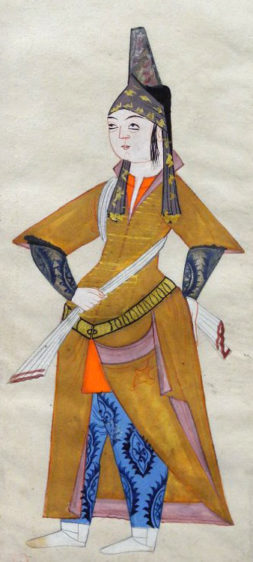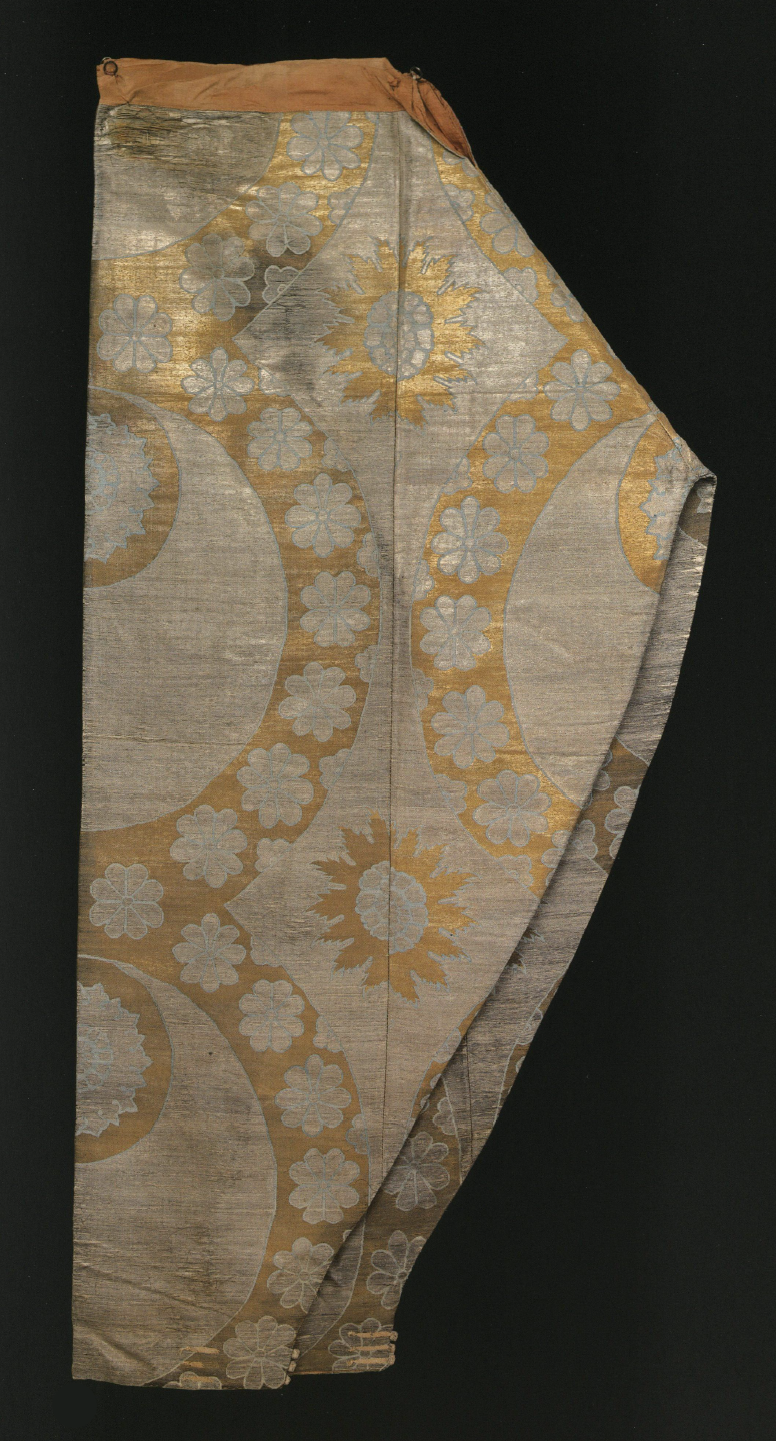
There were many, many styles of trousers in Ottoman Turkey, but the main style–and the only style women wore–was the çakşır (chahck-SHUR).
Contrary to the popular image of Ottomans in baggy trousers,
çakşır were fitted. Sometimes tightly fitted. The çakşır of the lady in the yellow kaftan are loose by period standard; most men are drawn wearing leg coverings that appear to be skin-tight from ankle to knee, and somewhat looser through the thigh. European drawings suggest that this may have been wishful thinking, but pants legs were still rather more close-fitting than we imagine them. There are even a few Turkish sources that show men wearing European-style garters tied below the knee, although this appears to have been a rarity.
Wait, there are drawings of men in baggy pants!
So there are. They’re limited to men in certain professions and activities, though: sailor, porter, shepherd, horseback rider. The vast majority of men shown in baggy pants are either on horseback, or recently dismounted.
Other professions that you’d expect to need equal freedom of movement, like soldier and foot messenger, wear fitted knee-length çakşır instead. The method of trouser construction used by 16th-century Ottomans tends to tug and bind more on the lower leg, so ending the trousers at the knee gives the wearer more freedom of movement, without the waste of inelegant swags of extra fabric.
Tastes changed over the course of the 17th century, and by the early 18th century, the voluminous trousers we know and love were the rule. But in the 16th century, slim-cut trousers were the rule.
Other Styles of Women’s Trousers
In addition to full-length çakşır, women wore knee-length çakşır (diz çakşır). We don’t have any pictures of women wearing them, but they were probably just short versions of regular çakşır.
Wait, Weren’t Pants Called Şalvar?
Not yet.
Nowadays, şalvar is the general term for any kind of trousers, especially loose traditional trousers of the kind worn by people from India to Anatolia. That usage dates to post-period. In the 16th century, şalvar were a specific style of trousers worn only by men, and not a popular style, either; by the 1650’s, şalvar were out of fashion. At some point afterward, the word “şalvar” was brought back and turned into an all-purpose term for pants.
It’s not clear what word 16th-century Ottoman Turks used as an all-purpose term. Given the number of çakşır people owned and the way they added “çakşır” to the names of other styles of trousers, I suspect it was “çakşır.”
What Were the Other Styles of Trousers?
These styles were worn only by men:
- Benevrek or menevrek
- Şalvar, defined in a 1533 dictionary as “chalzoni grandi oue a chammino si mettono le ueste” and in 1611 as “weite hosen wür (!) frauen,” wide trousers for women. The derivation is the Persian šalwār, “inner breeches, drawers reaching to the feet; sailor’s or traveller’s trousers.”
- Şalvar dolaması
- Tuman or tuman çakşır [link], defined in a 1533 dictionary as “chalze senza brachette,” trousers without flies(?), and in 1611 as “halbhosen,” half-trousers, or “unterhosen,” underpants. The derivation is the Persian tunbān, “short breeches; drawers; wrestler’s leathern breeches.”
Of these styles, the only one I can identify is the tuman, which an Ottoman Turkish dictionary defines as “Trowsers or drawers with very wide legs not gathered round the ankles by strings.”
Recreating Çakşır
Where Do I Find a Pattern?
The best pattern is Master Rashid’s. It’s simple, it’s quick, and it gives you a workable pair of çakşır that you can nip and tuck into the best shape for you. If you don’t like that pattern, any pattern for Indian shalwar of a similar shape will do just fine.
A geek warning: None of the extant 16th-century Ottoman Turkish pants in the Topkapi Palace collection were sewn using a cutting pattern like Master Rashid’s. Traditional patterns are designed to conserve cloth, while court garments were cut to display unbroken expanses of glorious brocade. Court tailors basically used the outline of a traditional pair of trousers, but moved seams around so they would fall on the inner leg. Here’s a pair of late 16th-century men’s çakşır from the Topkapi Palace collection:
The outer part of the leg is made of a folded piece of fabric, with the enormous çintamani motif centered on the fold so that it will show to the best advantage when viewed from the side. The seams fall in a section of the garment that, when worn, would be a mass of stiff folds, hiding both the seams and the inexpert pattern matching.
The takeaway is that even to the Ottomans, the cutting pattern mattered less than the shape. Once you’ve made a pair using Master Rashid’s pattern (or the pattern of your choice) and tweaked it to perfection, make a new, personalized pattern and adjust the cutting pattern to suit yourself.
Colors and Fabrics
Estate records (and the occasional drawing) document both full-length and knee-length women’s çakşır in red, light yellow, medium blue, and purple (a dark, modest color). A wealthy woman could no doubt have trousers in any color she liked.
The estate records aren’t forthcoming about the fabrics women used for their çakşır. There are a couple references to çakşır of silk satin, but that’s it. Men, whose legs showed more and who spent more time in the street or field, are recorded as owning çakşır of wool broadcloth, coarse aba wool, or felt, as well as luxury satin. And, of course, there are the men’s court trousers in brocade and in kutni (a soft silk-cotton mix) in the Topkapı Museum’s collection.
In practice, women probably used whatever they could afford. Their trousers were mostly hidden, so they saved their brocades for their zıbıns and kaftans, but satin and other substantial silks were fair game. Kutni and alaca, both colorful silk-and-cotton fabrics, would have also been suitable. Poorer women might have to make do with cotton twill (bogası) or plain-weave cottons and linens. And although wool trousers appear only in men’s estate inventories, women get cold, too.
Men would also have used the best materials they could afford, but estate records show a strong preference for wool. This makes sense, given trousers’ hose-like construction and the heavy wear men would have put them to. Wealthier men preferred wool broadcloth, poorer men preferred aba, and the very poor might have to do with felt.
The light, flowy cottons and silks we moderns are drawn to are too insubstantial for period çakşır. The Ottomans made their clothes to last. Tülbent and destâr, the period equivalents of cotton voile or batiste, were used for gömleks and underpants, but not outer clothes; vâle, a light plain-weave silk that might have been akin to a soft taffeta, was also used exclusively for undergarments. If authenticity is your goal, choose fabrics with some substance.
(That said, all my çakşır are made of cottons and linens so filmy that if they weren’t dark, they wouldn’t preserve my modesty. I hate sweating in garb.)
Don | Underpants Gömlek | Shift




